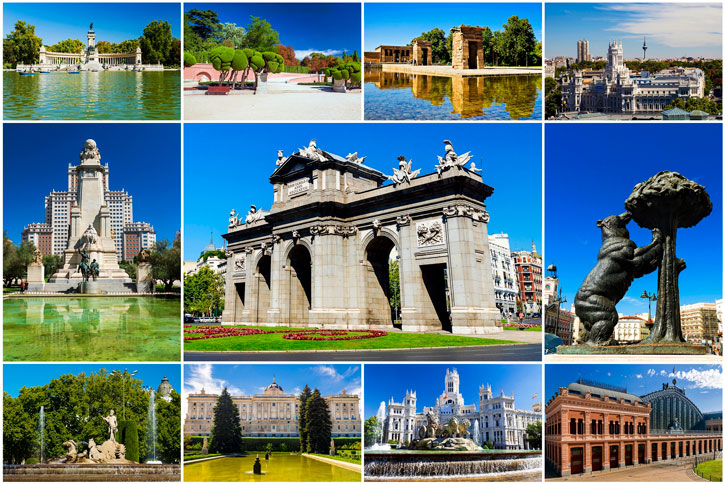Madrid, the vibrant capital of Spain, has long been a popular destination for expats from around the world, including those from the USA.
Spain offers significant economic and social advantages and enjoys excellent weather. When you add Madrid’s rich cultural heritage, dynamic lifestyle, and welcoming atmosphere, the capital becomes an attractive place to live.
If you are considering making the move to Madrid from the USA, this guide will provide you with all the essential information you need to transition smoothly. I will cover everything from visas and accommodation to employment, healthcare, and more. Let’s dive in!
Table of contents
- 1. Visa Requirements
- 2. Finding Accommodation
- 3. Finding Employment
- 4. Healthcare
- 5. Taxes
- 6. Language
- 7. Weather
- 8. Moving to Madrid with Kids
- 9. Relocating to Madrid with Pets
- 10. Cost of Living
- 11. Safety
- 11. Driving
- 12. Cultural Differences
- 13. Is Madrid a Good City to Move to from the USA?
- 14. Other Popular Cities in Spain Preferred by Americans
- Conclusion
1. Visa Requirements

Do You Need a Visa?
As a US citizen, you will need a visa and a residency to live in Madrid if your stay exceeds 90 days.
Main types of Visa
There are several types of visas available, depending on your purpose for moving to Madrid from the USA:
- Student Visa: For those planning to study in Spain. This visa is also issued for “au pair” stays.
- Work Visa: For individuals who have secured employment in Spain.
- Retirement – Non-Lucrative Visa: For those who can support themselves financially without working in Spain.
- Spain Digital Nomad Visa: For Digital Nomads and Remote Workers employed by non-Spanish companies.
How to Obtain a Visa
The visa application process can be lengthy, so it is important to start early. Here are the general steps:
- Determine the Type of Visa: Decide which visa category suits your situation.
- Gather Required Documents: This typically includes a completed application form, passport photos, proof of financial means, health insurance, and a background check. For more information, consult the Spanish consulate in the USA.
- Submit Your Application: Applications must be submitted to the Spanish Consulate that has jurisdiction over your area. The Consulate will send the documents to the Ministry of Foreign Affairs in Spain.
- Wait for Approval: The processing time varies but can take several months.
Once your application is approved, you can apply for a foreigner identification number (NIE) and a residence permit at a police station in Madrid. A visa grants permission to enter Spain, and residency allows you to live there.
This identification number is crucial for opening bank accounts, signing employment contracts, enrolling in the national health system, applying for driving licenses, and more.
Remember, the visa is a document issued by the Spanish Consulate in the USA that allows you to enter Spain. The residence permit is applied for once you have arrived in Madrid and allows you to reside in Spain for a longer period.
2. Finding Accommodation

When moving to Madrid from the USA, one of the primary considerations is the cost of housing.
Madrid, while more affordable than major US cities like New York or San Francisco, is still one of the most expensive cities in Spain. The cost of housing in Madrid can vary widely, but it is generally comparable to mid-sized US cities.
Additionally, the size of apartments in Madrid tends to be smaller than what you might be accustomed to in the United States.
If you are relocating with a family, it is advisable to look into the suburban neighborhoods. These areas offer a greater variety of apartments, houses, and residential complexes with amenities like swimming pools, all within a few miles of the city center and well-connected by public transport.
Types of Accommodation
Madrid offers a range of housing options to suit different preferences and budgets:
- Apartments: The most common choice for expats, ranging from small studios to large multi-bedroom units.
- Shared Flats: Renting a room in a shared apartment can be a more affordable option and a great way to meet people.
- Houses: Less common in the city center but available in suburban areas.
Popular Neighborhoods
When searching for where to stay in Madrid, some popular neighborhoods for expats include:
- Malasaña: Known for its bohemian vibe and nightlife.
- Chamberí: A more traditional area with a local feel.
- Retiro: Near the famous El Retiro Park, offering a blend of city life and green space.
- Salamanca: An upscale neighborhood with luxury shopping and dining.

Suburban Neighborhoods for Families
If you are moving to Madrid from the USA with a family, consider the suburban areas that offer more spacious living options such as Pozuelo de Alarcón, Las Rozas, and Majadahonda.
These are known for their high-quality schools, family-friendly atmosphere, and residential complexes with amenities like pools.
Madrid is generally a very safe city, but like any large city, it has areas that are best avoided. While the vast majority of neighborhoods are safe and welcoming, some areas may have higher crime rates or fewer amenities, making them less desirable for expats moving to Madrid from the USA.
Tips for Finding Accommodation
- Start Online: Websites like Idealista and Fotocasa are great for initial searches.
- Consider a Real Estate Agent: They can help navigate the market and find suitable options.
- Visit in Person: If possible, visit properties before committing to get a feel for the area and condition of the accommodation.
- Understand the Lease Terms: Ensure you understand the lease length, deposit requirements, and any additional fees.
Finding the right accommodation in Madrid involves balancing cost, location, and size, but with careful research and consideration, you will be able to find a home that suits your needs.
3. Finding Employment

Madrid is not only the capital of Spain but also its economic powerhouse, attracting businesses and professionals from around the globe.
The city boasts a diverse job market with opportunities in various sectors, including finance, technology, education, and tourism.
However, it is important to be aware of the unemployment rate, which has been a challenge in Spain. As of the latest data, Madrid has a lower unemployment rate (around 9%) compared to the national average, but it still presents some hurdles, especially for non-EU citizens.
Despite this, Madrid’s dynamic business environment and its ability to attract multinational companies make it a promising destination for job seekers.
How to Find a Job
- Online Job Portals: Websites like InfoJobs, LinkedIn, and Indeed are useful for job searches.
- Networking: Join expat groups, attend industry events, and leverage social media to make connections.
- Recruitment Agencies: Consider using agencies that specialize in placing expats.
- Language Schools: If you are an English speaker, teaching English can be a viable option.
Work Permits
To work legally in Madrid, you’ll need a work permit. This is typically arranged by your employer and must be approved before you start working.
4. Healthcare

Madrid offers an excellent healthcare system, which is one of the main attractions for expats moving to the city. Spaniards take pride in their public and universal healthcare system.
The Spanish healthcare system is known for its high quality and affordability, particularly in comparison to the USA. Both public and private healthcare options are available, ensuring that residents can find the right fit for their medical needs.
To qualify for public healthcare, you must register with Social Security. If you are employed, your employer will usually handle this.
Private healthcare
Foreigners with a residence permit who do not work or are not covered by Social Security must maintain private or public insurance that covers healthcare during their residence. Because of this requirement, they will not have access to public healthcare. Most visas require private health insurance coverage.
Moreover, many expats opt for private healthcare for shorter waiting times and English-speaking doctors.
Private insurance plans vary, so it is important to shop around and find one that fits your needs. Notably, private health insurance in Spain is significantly more affordable compared to the USA.
Pharmacies
Pharmacies are plentiful in Madrid, and pharmacists can provide advice and over-the-counter medications. Many are open late and on weekends.
5. Taxes

Understanding the tax system in Spain is essential for managing your finances effectively as an expat. While there are similarities to the tax system in the USA, there are also notable differences.
Familiarizing yourself with these taxes and seeking professional advice will ensure that you remain compliant and make the most of the financial opportunities available in Madrid.
Types of Taxes
These are the main direct and indirect taxes:
- Income Tax (IRPF): This is a progressive tax levied on individual income. The tax rates increase with higher income brackets, similar to the federal income tax system in the USA.
- Value Added Tax (IVA): VAT is a consumption tax added to the price of goods and services. The standard rate is comparable to sales tax in the USA, though it is typically higher than the average state sales tax rate.
You become a tax resident in Spain if you spend more than 183 days in the country within a calendar year.
Spain and the USA have a tax treaty to prevent double taxation, which means you won’t be taxed twice on the same income. However, you will still need to file tax returns in both countries.
Taxes can be complex, and an inadequate understanding can lead to fines and penalties. So it is advisable to consult a tax advisor who is knowledgeable about both Spanish and American tax laws.
6. Language

Learning Spanish is an essential part of integrating into life in Madrid.
While many people in younger demographics, tourist areas, and professional environments understand and speak English at least at a basic level, you may encounter more difficulties outside these settings.
Therefore, dedicating some time each day to learning Spanish is highly advisable.
Tips for Learning Spanish
- Enroll in Language Classes: Consider joining a language school. There are many options available, ranging from intensive courses to part-time evening classes.
- Language Exchange Meetups: Practice with locals in a relaxed setting. Language exchange groups are popular in Madrid and offer a great way to improve your Spanish while meeting new people.
- Use Language Apps: Apps like Duolingo, Babbel, and Rosetta Stone are useful for building vocabulary and practicing grammar on the go.
- Immerse Yourself: The best way to learn a language is through immersion. Try to speak Spanish as much as possible in your daily life. Simple interactions at the grocery store, in restaurants, or at social gatherings can significantly improve your fluency over time.
7. Weather

Madrid enjoys a Mediterranean-Continental climate characterized by hot summers and mild winters, making it a generally pleasant place to live. Knowing what is the weather like in Madrid can help you better prepare for your new life in Spain’s capital.
Seasonal Overview
Summer (June to September): Summers in Madrid are typically hot and dry, with temperatures frequently reaching the mid-30s Celsius (mid-90s Fahrenheit) and occasionally climbing even higher. July and August are the hottest months, often accompanied by heatwaves.
Despite the heat, the low humidity levels make the weather more bearable. It is common for locals and expats alike to escape to nearby coastal areas during the peak summer months.
Autumn (October to November): Autumn in Madrid is mild and pleasant, with temperatures gradually cooling down from the summer highs. September still feels quite warm, but by October, temperatures usually range between 15-25°C (59-77°F).
This season sees an increase in rainfall, although it is generally light and infrequent. Autumn is a great time to explore the city’s parks and enjoy outdoor activities without the intense summer heat.
Winter (December to February): If you are moving to Madrid from the USA you need to know that winters in Madrid are mild compared to many other European cities. Temperatures typically range from 2-12°C (36-54°F), with January being the coldest month.
Snowfall is rare but not unheard of, and when it does occur, it usually melts quickly. Winter is the wettest season in Madrid, but the rainfall is usually moderate.
Spring (March to May): Spring is one of the most enjoyable seasons in Madrid, with mild temperatures and blooming flora. Temperatures range from 10-20°C (50-68°F) in March and rise to 15-25°C (59-77°F) by May.
Rainfall decreases as the season progresses, and the weather becomes increasingly sunny. Spring is an ideal time for outdoor activities, sightseeing, and enjoying the city’s numerous parks and gardens.
8. Moving to Madrid with Kids

Moving to Madrid from the USA with your family can be an exciting adventure, filled with opportunities for new experiences and cultural enrichment.
The city offers a family-friendly environment with a wealth of resources to support children’s education and overall well-being. From excellent schools to numerous recreational activities, Madrid is well-equipped to cater to the needs of families.
Education in Madrid
Madrid boasts a wide range of educational options, from public schools to private and international institutions, ensuring that you can find a school that fits your kids’ needs and your family’s preferences.
Public Schools
Public schools in Madrid are funded by the government and offer free education to residents. These schools follow the Spanish curriculum, and instruction is primarily in Spanish. Attending a public school can be a great way for your child to immerse in the local culture and language.
Private Schools
Private schools in Madrid offer an alternative to the public system and often provide more individualized attention and resources. They may follow the Spanish curriculum or offer bilingual education, combining Spanish with another language, typically English.
International Schools
For expats, international schools are a popular choice. These schools offer curricula from various countries, including the American, British, and International Baccalaureate (IB) programs. International schools can provide a smoother transition for your children by continuing their education in a familiar system
Extracurricular Activities
Madrid offers a wide variety of extracurricular activities for kids, from sports to arts and music. Many schools provide after-school programs, and the city is home to numerous clubs and organizations that cater to various interests
. Parks, sports complexes, and cultural centers throughout Madrid offer spaces for children to play, learn, and grow outside the classroom.
9. Relocating to Madrid with Pets

Madrid is a pet-friendly city, making it an inviting destination for those moving with their furry companions.
The city’s numerous parks, pet-friendly accommodations, and a growing number of pet-friendly cafes and restaurants contribute to its appeal to pet owners.
However, when moving to Madrid from the USA with pets, it is crucial to comply with the current regulatory requirements for traveling with dogs, cats, and ferrets to ensure a smooth transition.
Pet-Friendly Housing
Finding pet-friendly accommodation can be challenging but not impossible. Specify your needs when searching and be prepared to pay a pet deposit.
Many landlords in Madrid are open to renting to pet owners, especially in suburban areas where larger properties with more outdoor space are available.
Veterinary Care
Madrid has many veterinary clinics offering high-quality care.
It is a good idea to find a vet soon after you arrive to ensure your pet’s health records are up to date and to establish a relationship for any future medical needs.
10. Cost of Living

Madrid is generally more affordable than other major European capitals like London or Paris, but the cost of living can vary widely depending on your lifestyle.
- Rent: Expect to pay between €1000-€1,500 per month for a one-bedroom apartment in the city center.
- Utilities: Monthly utilities (electricity, water, heating, cable TV, phone, wifi) typically cost around €150-€200.
- Groceries: A monthly grocery bill for one person is around €200-€300.
- Dining Out: A meal at a mid-range restaurant costs about €20-€25.
- Public Transport: Madrid has an efficient public transport system. A monthly pass costs around €50.
11. Safety

Madrid is a safe destination. Like other well-developed European cities, the living standards and personal safety are very high in Madrid.
According to the latest Safe Cities Index by The Economist Madrid ranks 10th in personal security. It is much better positioned than other top-rated tourist destinations such as London (14), Tokyo (16), Rome (23), New York (27), Los Angeles (29), Rio de Janeiro (36), and Mexico City (42).
Pickpocketing is the most common form of street crime in Madrid, especially around popular tourist attractions. Scams are also a risk around tourist spots.
11. Driving

As a US citizen, you can use your US driving license for up to six months. After that, you will need to obtain a Spanish license, which requires passing a theoretical exam and a driving test. The minimum driving age in Spain is 18 years old.
Driving in Madrid is generally safe. The roads are well-maintained, and Spain boasts one of the lowest numbers of traffic accidents in Europe.
Driving in Spain is not significantly different from driving in many other European countries in terms of rules and regulations. Still, it is worth checking out these 10 essential things to know about driving in Madrid before you take the wheel.
Finally, while owning a car in Madrid can be an option when moving to Madrid from the USA, it may not be necessary due to the city’s excellent public transport.
12. Cultural Differences

Social Life
- US: Social life in the US is often centered around private gatherings and planned events. Americans tend to have a more individualistic approach, with an emphasis on personal space and privacy.
- Madrid: In Madrid, social life is more communal and spontaneous. People frequently gather in public spaces, such as plazas and cafes, and it is common to see friends and families socializing late into the night. The Spanish lifestyle places a high value on social interaction and community.
Punctuality
- US: Punctuality is highly valued in the US, with a strong emphasis on being on time for appointments, work, and social events.
- Madrid: While punctuality is important in professional settings, there is a more relaxed attitude toward time in social situations. It is not uncommon for social events to start later than scheduled.
Dining Habits
- US: This is one of the most important points to keep in mind when moving to Madrid from the USA. Americans typically eat dinner between 6:00 PM and 7:00 PM. Meals are often quicker, with a focus on convenience and efficiency.
- Madrid: Dinner in Madrid is usually served much later, often between 9:00 PM and 10:00 PM. Tapas culture is also a significant part of social dining.
Food Culture
- US: American cuisine is diverse, reflecting the country’s multicultural population. Fast food is prevalent, and meals are often consumed quickly, emphasizing convenience.
- Madrid: Spanish cuisine emphasizes fresh, local ingredients and traditional recipes. Central to Spanish cuisine is the Mediterranean diet, renowned for its health benefits and delicious flavors. Olive oil is particularly cherished.
13. Is Madrid a Good City to Move to from the USA?

Moving to Madrid from the USA can be an exciting and transformative experience. As Spain’s capital and largest city, Madrid offers a rich blend of history, culture, and modern amenities.
Whether you are relocating for work, study, or a change of scenery, Madrid has much to offer. However, as with any major move, it is essential to weigh the pros and cons to determine if it is the right fit for you and your family.
Pros of Moving to Madrid from the USA
- Rich Cultural Experience: Madrid is a cultural hub, home to world-renowned museums such as the Prado, Reina Sofia, and Thyssen-Bornemisza. The city’s vibrant arts scene, historical sites, and frequent cultural events ensure that there is always something to explore and enjoy.
- Quality of Life: Madrid consistently ranks high for its quality of life. The city boasts a pleasant climate, excellent healthcare, and a relatively low cost of living compared to other major European capitals. The Spanish lifestyle, with its emphasis on socializing, good food, and relaxation, contributes to a high quality of life.
- Education: Madrid offers a variety of educational options, including public, private, and international schools. The presence of numerous international schools ensures that expat children can continue their education in a familiar system, whether it be American, British, or International Baccalaureate (IB).
- Safety: Madrid is considered a safe city with low crime rates compared to other large cities around the world. While petty crime like pickpocketing can occur, especially in tourist areas, violent crime is relatively rare.
- Healthcare: Spain’s healthcare system is excellent, providing high-quality medical services at a fraction of the cost of the USA. Both public and private healthcare options are available, and the overall healthcare standards are very high.

Cons of Moving from the USA to Madrid
- Language Barrier: While many younger people and professionals speak English, especially in tourist areas, Spanish is the predominant language. Outside these areas, you might encounter difficulties if you don’t speak Spanish. Learning the language is highly recommended for a smoother transition and better integration into local life.
- Bureaucracy: Moving to another country usually requires many bureaucratic processes, which can be slow and complicated. Whether it is dealing with visas, registering for healthcare, or setting up utilities, patience and persistence are often required.
- Employment: While Madrid has a dynamic job market, securing employment can be challenging, especially for non-EU citizens. The process of obtaining work permits and navigating the local job market may take time and effort.
- Housing Costs: Although Madrid is more affordable than cities like New York or San Francisco, it is still one of the most expensive cities in Spain. Finding affordable housing that meets your expectations can be challenging, particularly in central neighborhoods.
- Cost of Living: While the cost of living in Madrid is generally lower than in major US cities, it is higher compared to other parts of Spain. Expenses such as dining out and entertainment can be costly.
14. Other Popular Cities in Spain Preferred by Americans

While Madrid is a top choice for many Americans moving to Spain, several other Spanish cities attract expats from the United States due to their unique charms, lower costs of living, and appealing lifestyles.
Here are some of the most popular cities in Spain for American expats.
Barcelona
Barcelona, the capital of Catalonia, is a vibrant city known for its stunning architecture, cultural richness, and beautiful Mediterranean coastline. It combines the energy of a major city with the relaxed vibe of a beach town.
Valencia
Valencia, located on the eastern coast of Spain, offers a mix of traditional and modern attractions. It is known for its futuristic architecture, delicious cuisine (it is the birthplace of paella), and extensive green spaces.
Málaga
Málaga, located on the Costa del Sol, is known for its sunny weather, beautiful beaches, and thriving cultural scene. It offers a perfect blend of coastal and urban living.
Palma de Mallorca
Palma de Mallorca, the capital of the Balearic Islands, is a stunning Mediterranean city known for its beautiful beaches, historic architecture, and vibrant nightlife. It is a top destination for those seeking relaxation and sunny weather.
Conclusion

Moving to Madrid from the USA is an exciting adventure filled with opportunities for personal and professional growth.
By understanding the practical aspects of the move, from visa requirements and accommodation to healthcare and taxes, you can ensure a smoother transition.
Embrace the cultural differences, learn the language, and immerse yourself in the vibrant lifestyle that Madrid has to offer.
Whether you are drawn by the rich history, dynamic job market, or simply the allure of a new experience, Madrid is a city that welcomes expats with open arms. Happy moving!

